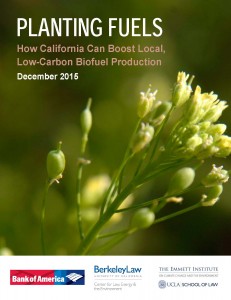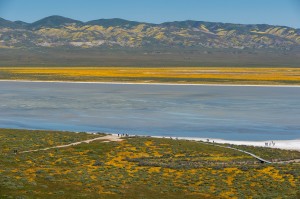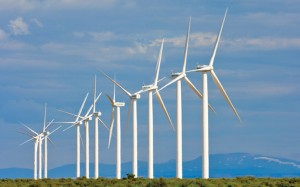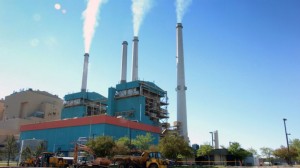The environmental policy news from Washington DC recently has not been great, to say the least. So it’s worth stopping to appreciate some recent wins.
First, in a surprising and close vote today, the U.S. Senate failed to overturn Obama administration regulations on methane emissions from fossil fuel extraction on public lands. Methane is one of the most harmful greenhouse gas pollutants, and this rule was critical to limiting those emissions.
Using the once-obscure Congressional Review Act, Congress could have not only wiped out the rule but also precluded the Bureau of Land Management from regulating in this area again. The oil and gas industry lost in the senate by one vote, with Sens. Susan Collins of Maine, Lindsey Graham of South Carolina and John McCain of Arizona the deciding votes (all Democrats voted against it).
Second, in the recent budget deal to keep the federal government funded through September, congressional negotiators saved the most important clean tech research agency, ARPA-E in the Department of Energy. As Utility Dive reported, ARPA-E actually received a $15 million boost instead of being eliminated, as the Trump administration had proposed.
Finally, the Caltrain electrification funding, which Congressional Republicans had held up because the electrification would one day get high speed rail to San Francisco, came through in the same budget deal with a partial amount of $100 million out of the original $647 million. It’s no guarantee that the rest of the dollars will be approved, but it’s a good sign.
So while the news can be gloomy on the environment, and there are a lot of battles still to come, it’s good to see common sense rule-making and investments still moving forward right now.
Bret Stephens, the New York Times’ new columnist, got the climate change world into an outrage with his first column last week, which compared climate science to Hillary Clinton’s pre-election polling and argued for restraint from climate advocates.
In his follow up column today, he took a more measured tone, noting that he believes the Earth is warming but that we’re not being careful on the solutions:
“The British government provided financial incentives to encourage a shift to diesel engines because laboratory tests suggested that would cut harmful emissions and combat climate change. Yet, it turned out that diesel cars emit on average five times as much emissions in real-world driving conditions as in the tests, according to a British Department for Transport study.”
In other words, to say we want to take out insurance for climate change is perfectly sensible. But whether we know we’re buying the right insurance, at the right price, is less clear, and it behooves us to look closely at the fine print before we sign on.
As someone who works day in and day out on climate mitigation policies, I can tell you that Stephens is cherry-picking from a handful of bad examples.
Take his reference to the ethanol subsidies, which resulted from the federal renewable fuel standard, established during the second Bush administration. Yes, the standard did spur more Midwestern corn production to be used for biofuel.
But the policy was never really a climate mitigation measure. It was primarily meant to boost domestic fuel sources, with greenhouse gas reduction as an added selling point but no strict carbon screen on the fuels. If there was a strong carbon screen on the kind of fuel that could qualify, very little of that high-carbon Midwestern corn-based ethanol would have qualified (hence the opposition to the standard even from some environmentalists).
For a better climate policy model on biofuels, just look to California. The state’s low carbon fuel standard (which encourages biofuel production like the renewable fuel standard but with a strong low-carbon requirement) disfavors land-intensive corn for true low-carbon biofuel, like in-state used cooking oil (surprisingly a growing percentage of the state’s biofuel).
Stephens’ reference to the British diesel problem is also unfortunate. Most climate policy experts will tell you that the best way to reduce emissions from transportation is through battery electric vehicles, as long as the electricity doesn’t come exclusively from coal-fired power plants (in which case hybrid vehicles yield better carbon reductions). Other fuels that can work include low-carbon biofuels and possibly hydrogen, depending on the energy source used to produce it. Diesel isn’t on the list, at least in places like California, unless it’s biodiesel.
 On that subject, biodiesel does emit conventional pollutants, an issue we’re grappling with in California, as evidenced by the POET lawsuit against the California Air Resources Board’s low carbon fuel standard. Biodiesel is great at reducing carbon emissions but also emits nitrogen oxide (NOx) — a subject we covered in Berkeley/UCLA Law’s 2015 Planting Fuels report.
On that subject, biodiesel does emit conventional pollutants, an issue we’re grappling with in California, as evidenced by the POET lawsuit against the California Air Resources Board’s low carbon fuel standard. Biodiesel is great at reducing carbon emissions but also emits nitrogen oxide (NOx) — a subject we covered in Berkeley/UCLA Law’s 2015 Planting Fuels report.
Resolving this conflict among pollutants will take a policy balancing act, but it ultimately shouldn’t obscure the huge economic and environmental benefits from switching transportation fuels from petroleum to electricity and low-carbon biofuels. Stephens simply ignores this tried-and-true approach, which is resulting in swift advancements in electric vehicle adoption in places like California, Europe, and even China.
To be sure, care is needed when it comes to developing climate policies, and I’d agree with Stephens on that front. But the main concern is around managing the economic impacts of transitioning the grid and transportation fuels to cleaner sources. We have to go slow to avoid price shocks and bring the costs of these new technologies down.
California is doing just that, with a measured, careful plan to bring down the emissions curve steeply over the coming decades. Our economy is now less carbon intensive than it was in the 1990s and has been growing rapidly, too — which is at least an indication that climate policies aren’t getting in the way, if not actually serving as a boost.
There’s no reason that the country as a whole can’t follow suit, except that we have national writers like Stephens who cherrypick their way into sounding like reasonable skeptics — when they’re really just misleading people.

Will this place still be “Carrizo Plain National Monument” after Trump’s administration has its way? Photo by Steve Hymon
In these first 100 days, our new president has backtracked on many promises, completely reversed course in others, and demonstrated an alarming disregard for the truth.
It’s enough to make some political observers think that he’s basically a malleable mishmash of blathering, with his only core desire to self-promote and perhaps increase his riches from from his various business dealings.
As Andrew Sullivan wrote recently:
What on earth is the point of trying to understand him when there is nothing to understand? Calling him a liar is true enough, but liars have some cognitive grip on reality, and he doesn’t. Liars remember what they have said before. His brain is a neural Etch A Sketch. He doesn’t speak, we realize; he emits random noises. He refuses to take responsibility for anything. He can accuse his predecessor and Obama’s national security adviser of crimes, and provide no evidence for either. He has no strategy beyond the next 24 hours, no guiding philosophy, no politics, no consistency at all — just whatever makes him feel good about himself this second. He therefore believes whatever bizarre nonfact he can instantly cook up in his addled head, or whatever the last person who spoke to him said. He makes Chauncey Gardiner look like Abraham Lincoln. Occam’s razor points us to the obvious: He has absolutely no idea what he’s doing. Which is reassuring and still terrifying all at once.
That may be true when it comes to Trump personally and as a politician. But it does not apply when it comes to his appointees in the administration on the environment. Because across-the-board, the administration seems motivated by one thing when it comes to the environment, and that’s boosting the oil, gas, and coal industries at the expense of everything else.
There are too many examples to cite, but it’s worth going through some of them:
- Attempting to roll back key regulations like the Clean Power Plan and the fuel economy standards
- Gutting the budget for the Environmental Protection Agency, Department of Energy clean tech research, and public transit, among others
- Overturning environmental regulations with Congress through use of the once-obscure Congressional Review Act
- Reviewing, with the likely intent of undoing, prior national monument designations, including the Carrizo Plain here in California that I recently profiled.
So while Trump may be incoherent and bereft of some core principles, he has empowered an administration full of individuals dead set on boosting oil, gas, and coal exploitation, at the expense of the environment and public health.
 Sammy Roth at The Desert Sun penned an engaging deep dive on the issues confronting California and the west if the state expands its grids into traditionally coal- and Republican-dominated states like Idaho and Wyoming.
Sammy Roth at The Desert Sun penned an engaging deep dive on the issues confronting California and the west if the state expands its grids into traditionally coal- and Republican-dominated states like Idaho and Wyoming.
It’s an important issue, because as California produces more renewable energy than it can use locally, it will need markets to export that surplus. Similarly, the state will need to import surplus renewables (like wind from Wyoming and morning sun from Utah) when our wind and solar output is weak.
The upside for ratepayers is potentially huge savings (as Greentech media also described last December), while the upside for environmentalists is more renewable energy capacity without needing backup fossil fuel plants. And long term, more renewable development in these conservative states could change the politics there, as a domestic clean tech industry may lobby for more favorable policies.
But the expansion is held up by two factors: first, concern that grid expansion will throw a lifeline to out-of-state coal-fired plants that would otherwise get shuttered (environmentalists are split on whether that would happen, but California’s grid operator does anticipate a slight increase in greenhouse gas emissions from the plants in the short term, with significant long-term reductions); and second, disagreements over how grid governance would work across such diverse states:
“There’s not going to be any scenario where I would agree to a situation where the California Legislature is dictating policy to the state of Wyoming,” Matt Mead, Wyoming’s Republican governor, said in an interview. “Clearly, Wyoming is the No. 1 coal-producing state. It probably has a different perspective than California does.”
The mistrust cuts both ways. Officials in Idaho, Utah and Wyoming — deep-red states that rely on coal and other fossil fuels and don’t see climate action as a priority — don’t want to give coastal liberals too much power to decide which types of energy they use. Lawmakers in California, Oregon and Washington, but especially California, have the same concern about the red states.
If the governance issues cannot be solved, I wonder if a possible interim solution might be to focus on immediate grid expansion just to Oregon and Washington, given their similar politics and commitment to renewables. Then in future years it could expand to more fossil fuel-dependent states, once the market and governance kinks have been ironed out.
Meanwhile, the article is worth checking out just for the interactive map of every type of power plant in the entire U.S., including pumped storage facilities (I can’t reproduce it on my blog here but you can find it about 2/3 of the way down the article).
Supposedly the California legislature will debate grid expansion later this year, although I understand there’s a lot of skepticism from legislators, particularly about having California policies provide economic benefits out-of-state. But in the long term, it’s hard to see how California can achieve deep decarbonization in the electricity sector without this kind of regional approach.
My favorite clean tech federal agency is hands down ARPA-E, which as I blogged before is the most important agency you’ve never heard of. It’s funding breakthrough clean technologies and having tremendous success bringing risky and innovative tech to market.
So of course the Trump administration is doing everything it can to undermine the agency. In addition to zeroing it out for funding in its proposed (but probably DOA) budget, Trump’s team now has the agency halting approved grants from going out the door.
It’s a frustrating decision, because these technologies are exactly the kind of thing we want to incubate and develop here in America — if not for the environmental benefit then at least for the economic gains.
ThinkProgress has a nice description of the agency’s work that is now threatened, including this success story:
The agency is focused on “high-impact, high-risk and high-reward” projects, Townsend noted, and he agreed with the former program director that these are areas in which the private sector likely would not invest. For example, researchers for a group called Makani Power created a wind turbine project, funded by ARPA-E, that sends airborne kite-like wind turbines high into the air where they harness a more consistent and powerful wind source than earthbound wind turbines. Makani Power designed the drone kites to automatically take off and adjust themselves to the windstream to maximize energy production.
ARPA-E awarded Makani Power a $3 million grant in 2009 for the project. In 2013, Google X, the search engine company’s research and investment arm, acquired Makani Power, turning the research project into a success story for ARPA-E.
Let’s hope this freeze on grants is temporary, and that the agency’s bipartisan allies in Congress can save the day when it comes to longer-term funding.
We certainly need cheap renewables like solar, coupled with batteries, to clean our grid and mitigate climate change. But these technologies also hold incredible promise as economic development lifelines for remote indigenous communities.
The Guardian recently profiled a growing indigenous renewable energy alliance in Australia:
Only a handful of Indigenous communities have embarked on renewable energy projects in Australia. The Indigenous-owned and -operated company AllGrid Energy, for instance, has installed solar panels and battery storage systems to replace diesel generators in the Aboriginal communities of Ngurrara and Kurnturlpara in the Northern Territory’s Barkly Tableland. Within two months of the system being installed in May 2016, people were moving back to their homelands from Tennant Creek, the communities growing from just two permanent residents to about 40.
As these technologies become cheaper, not only will the developed world benefit, but historically disadvantaged communities across the globe will have access to clean, cheap power for their hospitals, homes and businesses.
With the Trump administration putting the brakes on national climate efforts, such as the Clean Power Plan, action will shift to the states. But California is doing more than just reducing its own carbon footprint, it’s signing up cities and states around the world to commit to the same.
Capitol Public Radio ran a story yesterday on the “Under 2 MOU,” which is the memorandum that binds the coalition states to reduce greenhouse gases to under 2 degrees warming by 2100. International law students in a class I helped teach at Berkeley Law helped develop new strategies for their home country jurisdictions and were featured on the radio piece:
…Ken Alex, who oversees the organization for Jerry Brown, says the organization has little, if any, stable funding.“We’re learning, we’re building the airplane as we’re flying it,” Alex says. He notes the organization has more signatories than the Paris Agreement. “And oh by the way there are at least 10 languages.”He counts one full-time employee working on it. Instead, Under2 has largely relied on informal arrangements.For instance, a U.C. Berkeley professor who does work in Kenya helped Laikipia calculate its total emissions. Another class at Berkeley law school, made up of international students with law degrees in their home countries and taught by a former colleague of Alex’s, is scouting potential new allies.
The work of the international students is helping to identify new potential coalition partners and strategies for existing ones to follow through on their pledges. It’s a shining example of state and local leadership — around the world — at a time when our federal government appears to be moving backwards.
Yesterday was a frustrating day for those who care about tackling climate change. Donald Trump’s executive order to roll back most of the Obama Administration’s efforts to reduce greenhouse gas emissions is probably a futile attempt to resuscitate the dying coal industry, while putting America’s climate leadership on ice for at least the next four years. In other words, it’s a pointless, counter-productive exercise.
Yet while the moves are disappointing, they’re not devastating. The executive order will set in motion a regulatory process that will take years to play out and that will likely face strong resistance from the courts. But they mean a giant delay in needed actions.
I commented on the moves yesterday in some media outlets in both Los Angeles and the San Francisco Bay Area. First, I appeared on KPCC radio’s AirTalk in Los Angeles, discussing the impact of the order.
In the afternoon, I spoke with ABC-7 News in the Bay Area. Video here:
So the action now will shift to the courts, and we’ll see what the administration does with the Paris agreement on climate change going forward.
 Back in January, Berkeley Law and labor market researchers released a report on the economic and employment impacts of California’s ambitious climate policies on the San Joaquin Valley. The Economic Impacts of California’s Major Climate Programs on the San Joaquin Valley addressed compliance and investment costs as well as the benefits across the region.
Back in January, Berkeley Law and labor market researchers released a report on the economic and employment impacts of California’s ambitious climate policies on the San Joaquin Valley. The Economic Impacts of California’s Major Climate Programs on the San Joaquin Valley addressed compliance and investment costs as well as the benefits across the region.
Ultimately, our research team found that the economic benefits of California’s major climate programs exceed costs. It was the first comprehensive, academic study of the costs and benefits of these policies on this economically and environmentally distressed region.
To discuss the findings, the Center for Law, Energy & the Environment (CLEE) at Berkeley Law will host a one-hour webinar with the report authors on Wednesday from 1 to 2pm. In addition to yours truly, the webinar will feature:
- Betony Jones, UC Berkeley Labor Center
- F. Noel Perry, Next 10
You can register for this event here. Hope you can tune in and ask your questions!


